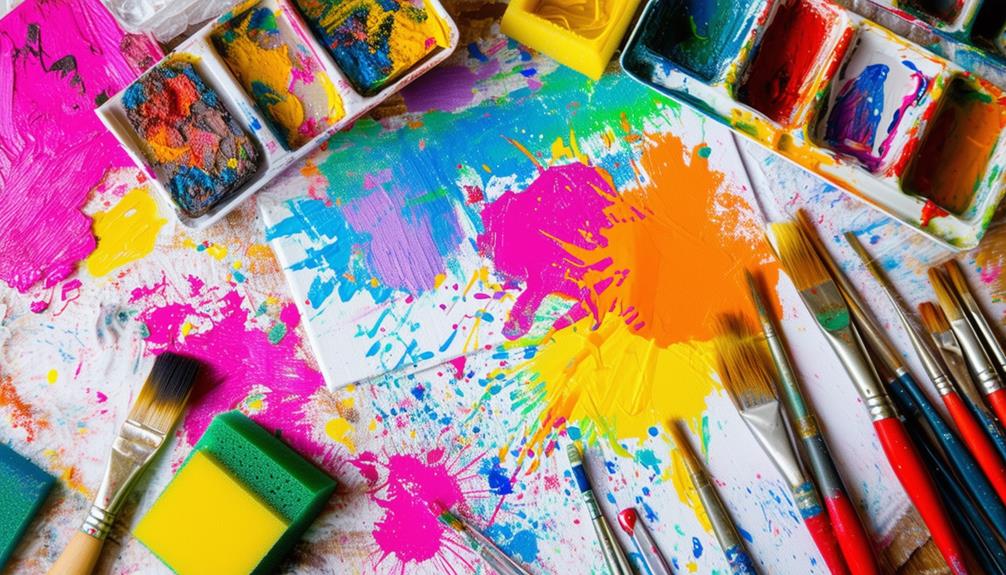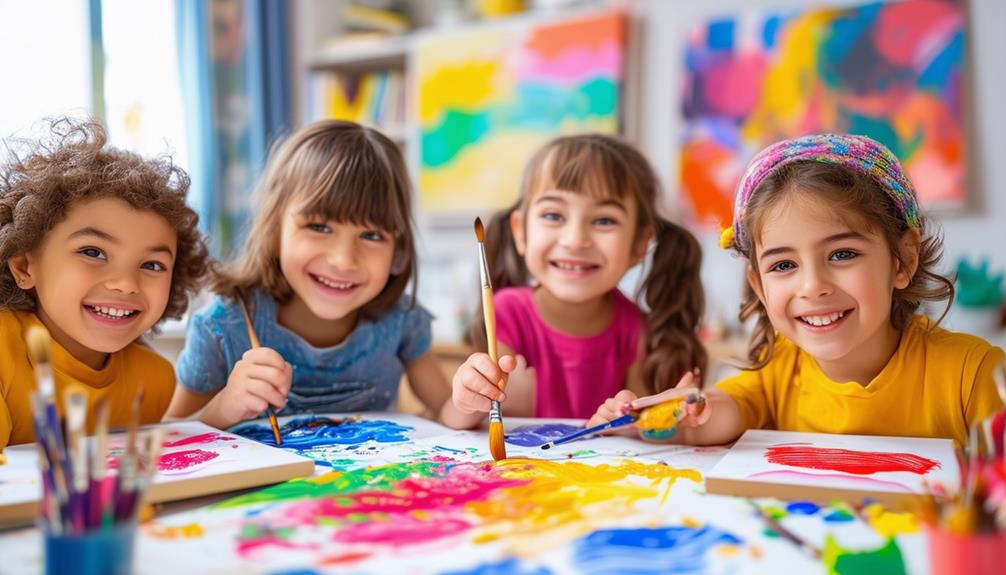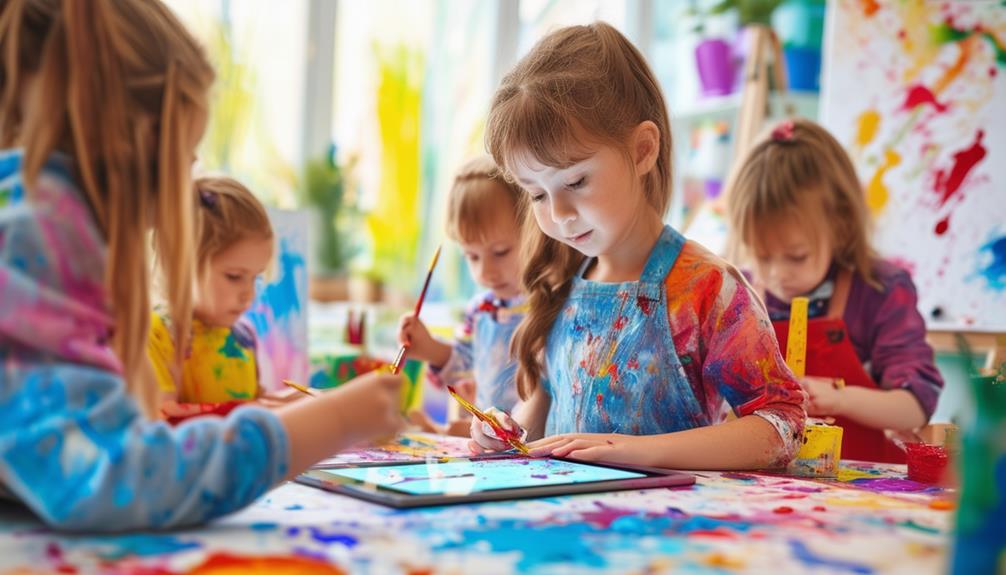Painting for Sensory Development: Texture and Touch
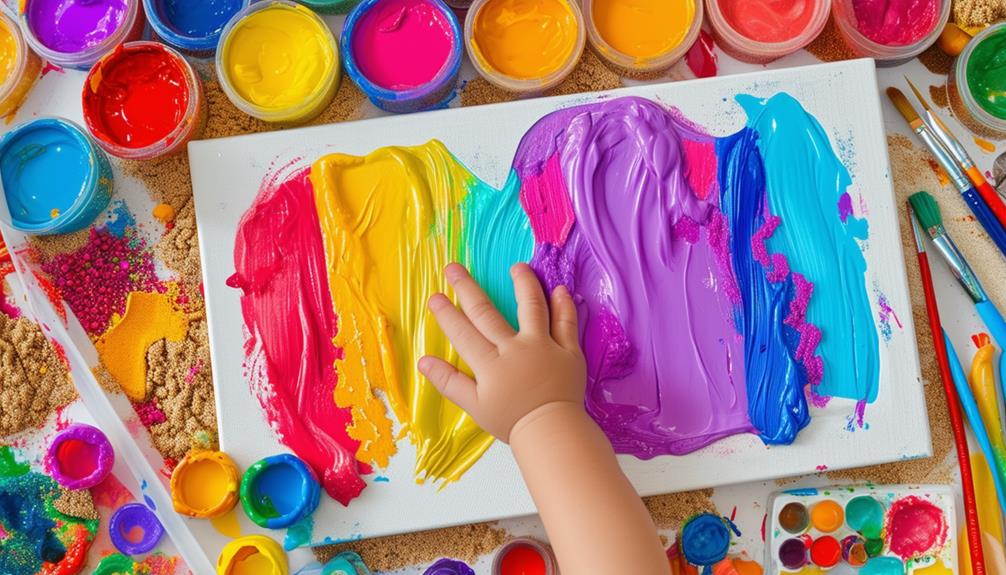
When you introduce children to painting that emphasizes texture and touch, you unlock a realm of sensory exploration that enhances cognitive development and creativity. Imagine the varying sensations they experience from using materials like sand, salt, or coffee grounds mixed into paints. Each stroke not only hones fine motor skills but also enriches their descriptive language abilities. Have you considered how using tools like sponges or toothbrushes can revolutionize their artistic expression and tactile understanding? This method of painting goes beyond art; it engages all the senses in a meaningful way. So, what happens when you take this a step further?
Benefits of Finger Painting
Finger painting offers a multifaceted developmental experience for children. It enhances fine motor skills, eye-hand coordination, and gross motor movements. When children engage in finger painting, they are not merely having fun; they are also delving into valuable sensory exploration. This activity allows them to experiment with colors, shapes, and lines, stimulating their tactile senses.
As children dip their fingers into paint and spread it across the paper, they develop better control over their hand and finger movements, which is crucial for tasks such as writing and buttoning clothes. Additionally, coordinating their hands with their eyes to create specific shapes or lines enhances their eye-hand coordination.
Finger painting also involves full-body movements, which promote balance and large muscle control. Moving around their painting space helps children become more aware of their bodies and how they interact with their environment, fostering spatial awareness.
Moreover, the tactile experience of finger painting provides a unique medium for children to convey ideas and express emotions. With continuous access to materials, children can investigate and express their creativity, further honing their mark-making skills.
Exploring Different Textures
Experimenting with various textures in painting activities can significantly enhance your child's sensory development and creativity. By incorporating materials such as coffee grounds, salt, and sand into painting sessions, you provide unique tactile experiences that engage their senses. Using their fingers to spread textured paints, children develop fine motor skills and an awareness of different surfaces, deepening their sensory perception.
Encourage your child to use tools like sponges and toothbrushes to add depth and varied textures to their artwork. These tools create different patterns and sensations, making the painting process more interactive and exciting. Oversized hand shapes on easel paintings offer another method for tactile exploration, allowing children to feel diverse textures and experiment with manipulating paint.
Introduce textured alphabet letter boards to make learning more sensory-rich. These activities help children connect letters with tactile experiences, enhancing both their language skills and sensory development. Through these methods, you create a rich, multi-textured environment that fosters creativity and learning through touch and texture.
Creating Salt Paint

To create salt paint, you'll need salt, paint, and a mixing medium. Begin by combining these ingredients to form a paste. Apply the mixture using brushes or other tools. This activity introduces children to new textures and enhances their sensory learning and fine motor skills.
Materials and Preparation
To create salt paint, gather the following materials: your chosen paint colors, cooking salt, and sturdy surfaces like recycled white cardboard or heavy paper. Begin by mixing the paint with the salt, which will produce raised and bumpy textures. This activity is enjoyable and educational for children, providing a unique sensory experience that fosters creativity.
Prepare your workspace by ensuring you have enough room to spread out your materials. Use recycled white cardboard or heavy paper as your painting surface. These materials are strong and eco-friendly. The dried salt paint will result in hard and bumpy textures, which are excellent for older children to trace letters on, adding an educational twist to the activity.
Here's a quick checklist to help you get started:
| Material | Quantity Needed | Notes |
|---|---|---|
| Paint Colors | As desired | Choose non-toxic paints for children |
| Cooking Salt | 1-2 tablespoons | Adjust quantity based on paint volume |
| Cardboard/Paper | 1 per child | Recycled white cardboard or heavy paper |
| Brushes | 1 per child | Wash thoroughly after use to avoid residue |
This checklist ensures you have all the necessary materials, providing a safe and organized way to engage children in a creative and educational activity.
Application Techniques
Now that you've gathered your materials, let's delve into the techniques for creating and applying salt paint. Begin by mixing salt with your chosen paint colors. This mixture will produce a raised and textured surface, ideal for sensory exploration. Salt paint is not only cost-effective but also a fun way to introduce diverse textures into your artwork.
Start by selecting a piece of recycled white cardboard or heavy paper as your canvas. The sturdiness of these materials will support the weight and texture of the salt paint. Use a brush or your fingers to apply the paint to the canvas. Experiment with different application techniques to create unique patterns and textures.
As the salt paint dries, it will harden and form a bumpy surface. This texture makes it perfect for sensory activities, such as tracing letters or simply touching to feel the different textures. The tactile experience can encourage discussions about how the paint feels and looks, providing a wonderful way to engage learners.
Educational Benefits
Creating salt paint offers a wealth of educational benefits, enhancing sensory learning and fine motor skill development. Through sensory play with salt paint, children explore raised and bumpy textures, stimulating their tactile senses. These experiences help them understand different textures and initiate conversations about how materials dissolve and interact, thereby enriching their vocabulary and comprehension.
Engaging children in the process of making salt paint also promotes fine motor skills. As they stir salt into the paint, they practice precise hand movements and coordination, which strengthens their grip and control. This hands-on activity builds their confidence as they see the tangible results of their efforts.
Moreover, salt paint provides a unique and interactive painting experience that nurtures creativity and discovery. Children are actively involved in every step, from mixing the paint to applying it on paper. This engagement fosters a sense of accomplishment and a deeper understanding of the creative process.
Using Textured Finger Paints
Using textured finger paints offers notable benefits for sensory development. Mixing materials like salt, flour, or shredded coconut into washable paint creates unique textures that children can explore with their hands. This activity not only enhances their sensory experiences but also stimulates creativity and promotes descriptive language skills.
Benefits of Textured Paints
Textured finger paints offer a rich sensory experience that enhances children's tactile awareness and fine motor skills. By engaging in tactile exploration, kids can differentiate between diverse textures, improving their sensory perception. Adding mix-ins like salt, flour, orzo pasta, and shredded coconut to paints creates unique textures, making painting both exciting and educational.
When children use textured finger paints, they not only develop their tactile senses but also enhance their fine motor skills. Manipulating different materials in the paint encourages precise hand movements and coordination. This process promotes creativity and expressive language development as kids describe what they feel and see.
Using a variety of materials in textured finger paints provides a fun and engaging way for children to learn about different textures. It turns a simple art activity into an exploration of the physical properties of materials, making the learning process enjoyable and memorable. Additionally, incorporating these paints in art activities supports cognitive development and artistic expression, allowing children to experiment and create freely.
Enhancing Sensory Experiences
Enhancing children's sensory experiences during painting activities can be achieved by incorporating various mix-ins like salt, flour, or shredded coconut into washable paints. Textured finger paints are not just enjoyable; they are essential for sensory development. These materials create diverse textures for children to explore.
Encourage children to use their fingers or hands to spread the textured paints, observing how each mix-in alters the paint's feel and behavior. For instance, salt can create a clumpy texture, while orzo pasta offers a unique tactile sensation. These activities help kids become more aware of different textures and enhance their descriptive language skills as they articulate their sensory experiences.
This sensory exploration also promotes creativity and fine motor skills. As children manipulate the varied textures, they develop the muscles in their hands and fingers. This hands-on artistic activity is crucial for young children's sensory development.
Hands-On Painting Techniques
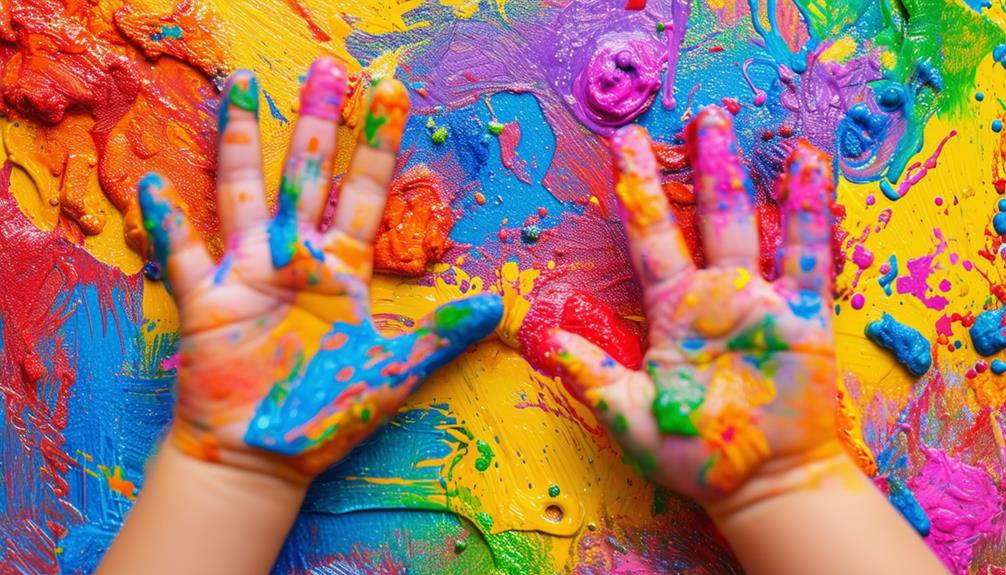
Transitioning from finger painting to using whole hands allows children to deepen their tactile exploration and creativity. By engaging their entire hands, children enhance their sensory development through varied painting techniques. This method promotes playful and messy discovery, enabling kids to express their preferences for different textures and materials. Here are some effective hands-on painting techniques:
- Palm Printing: Encourage children to dip their palms into paint and press them onto paper, experiencing the squishiness and texture of the paint.
- Sponge Painting: Provide a variety of sponges for kids to dip in paint and press onto paper, creating diverse patterns and textures.
- Foam Rollers: Let children use foam rollers to spread paint across large surfaces, giving them a sense of control and an appreciation for different textures.
- Bubble Wrap Stamping: Wrap bubble wrap around their hands, dip it in paint, and stamp it on paper to create a unique, bumpy texture.
These techniques foster creativity and sensory experiences, making art a joyful, tactile activity. They also help children develop fine motor skills as they explore different textures and materials, enhancing their sensory development in engaging ways.
Sensory Play and Learning
Engaging children in sensory play through painting stimulates cognitive development and fosters creative expression. When kids explore paint with their hands, sponges, or toothbrushes, they are not just having fun; they are learning. Sensory play enriches cognitive growth by exposing children to diverse textures, which enhances their exploration and descriptive language skills. For example, painting with materials like coffee grounds and sand not only creates interesting artwork but also engages kids in tactile learning.
Incorporating various tools in painting activities helps develop fine motor skills and expands sensory experiences. Easel painting with oversized hand shapes is particularly effective, as it encourages children to investigate textures and shapes, fostering a deeper understanding of their sensory world. This hands-on approach allows them to feel differences and similarities in textures, thereby improving cognitive development.
Encourage children to describe what they feel and see during these activities. This practice helps them articulate their sensory experiences and observations, enriching their language skills. By combining sensory play with painting, you create a rich, multi-sensory learning environment that supports both cognitive and creative growth.
Art Projects for Kids
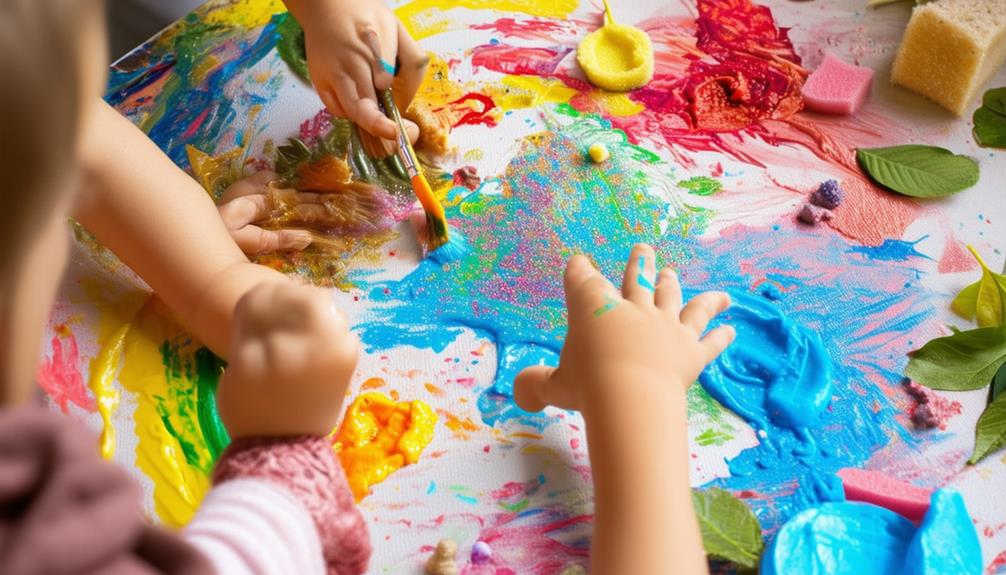
Discover imaginative and engaging art projects designed to enhance children's sensory development and artistic expression. In early childhood education, art projects that focus on texture and touch offer a unique experience that boosts both creativity and sensory skills.
Children can explore various tactile sensations by incorporating materials like salt, sand, and coffee grounds into their paintings. This approach not only makes the artwork visually appealing but also enhances their sense of touch. Additionally, using different tools such as sponges and toothbrushes can further improve their fine motor skills and creative thinking.
Here are some exciting art projects you can try:
- Easel Painting with Oversized Hand Shapes: Encourage tactile exploration by allowing children to paint around large hand cutouts, adding layers of texture and color.
- Textured Alphabet Boards: Create boards with different materials attached to each letter, promoting both creative expression and language development.
- Salt and Sand Painting: Mix these granules into paint for a gritty, textured experience that kids will enjoy both touching and seeing.
- Coffee Ground Art: Use coffee grounds to introduce a unique texture and earthy hue to paintings, engaging multiple senses.
These projects offer a solid foundation to nurture sensory development through the joy of art.

